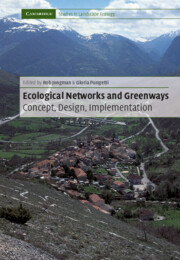Book contents
- Frontmatter
- Contents
- List of contributors
- Foreword
- Preface
- Acknowledgements
- 1 Introduction: ecological networks and greenways
- 2 The context and concept of ecological networks
- 3 Greenways in the USA: theory, trends and prospects
- 4 Ecological functioning of ecological networks: a species perspective
- 5 Impacts of roads on ecological networks and integration of conservation and transportation planning: Florida as a case study
- 6 Ecological corridors on a European scale: a typology and identification of target species
- 7 Planning the future landscape between nature and culture
- 8 From models to reality: design and implementation process
- 9 Design of the Pan-European Ecological Network: a national level attempt
- 10 Ecological ‘black spots’ within the ecological network: an improved design for rural road network amelioration
- 11 An ecological network for the Milan region based on focal species
- 12 Connecting corridors: implementing metropolitan greenway networks in North America
- 13 The Florida Statewide Greenways Project: its realisation and political context
- 14 The ecological network development in the Yungas, Argentina: planning, economic and social aspects
- 15 The river corridor of the Guadiamar
- 16 Conclusions: into the twenty-first century
- References
- Index
1 - Introduction: ecological networks and greenways
Published online by Cambridge University Press: 29 December 2009
- Frontmatter
- Contents
- List of contributors
- Foreword
- Preface
- Acknowledgements
- 1 Introduction: ecological networks and greenways
- 2 The context and concept of ecological networks
- 3 Greenways in the USA: theory, trends and prospects
- 4 Ecological functioning of ecological networks: a species perspective
- 5 Impacts of roads on ecological networks and integration of conservation and transportation planning: Florida as a case study
- 6 Ecological corridors on a European scale: a typology and identification of target species
- 7 Planning the future landscape between nature and culture
- 8 From models to reality: design and implementation process
- 9 Design of the Pan-European Ecological Network: a national level attempt
- 10 Ecological ‘black spots’ within the ecological network: an improved design for rural road network amelioration
- 11 An ecological network for the Milan region based on focal species
- 12 Connecting corridors: implementing metropolitan greenway networks in North America
- 13 The Florida Statewide Greenways Project: its realisation and political context
- 14 The ecological network development in the Yungas, Argentina: planning, economic and social aspects
- 15 The river corridor of the Guadiamar
- 16 Conclusions: into the twenty-first century
- References
- Index
Summary
Nature conservation and landscape ecological principles
The concepts of ecological networks and greenways relate to the human environment and its development. Recent advances in environmental philosophy have shown the fragility of the concept of ‘nature’. New avenues have been opened up, from the new genetic and reproductive technologies to the awareness that the continuous loss of nature is a ‘foundational concept, a ground of being, a stable otherness to the human condition’ (Robertson et al. 1996).
Yet the beginning of the third millennium reveals a moment in which changes in social, scientific and technological sectors are rapid and multiple. In a dynamic environment changes in nature too become more and more human-driven, while the landscape becomes human-dominated. The natural environment has thus been gradually fragmented and now retains sets of habitats and species that cannot survive in isolation.
Within this framework, new philosophical directions in environmental sciences have stressed the importance of moving from isolation to connection and from a concentric to a peripheral approach. Nature conservation, accordingly, is moving from local to global. If the previous focus was primarily on areas of high nature concentration, e.g. national parks, now the focus is moving towards linkages between them and linkages between nature and the human environment such as greenways, ecosystem coherence and ecological networks. These concepts have recently become familiar in ecological language at both the scientific and the public level.
The above considerations are significant for environmental conservation and sustainable development, which should in turn become priority issues for national and regional authorities.
- Type
- Chapter
- Information
- Ecological Networks and GreenwaysConcept, Design, Implementation, pp. 1 - 6Publisher: Cambridge University PressPrint publication year: 2004
- 7
- Cited by

